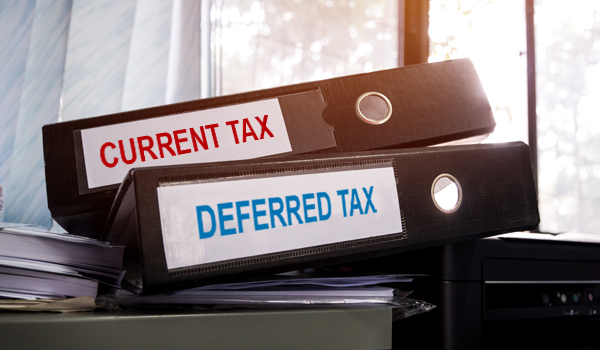 Introduction
Introduction
An integral part of our economic lives is the accounting for and paying of income taxes. In terms of the International Financial Reporting Standards for Small and Medium Sized entities (IFRS for SMEs), income tax comprises current tax liabilities (or assets) and deferred tax liabilities (or assets). What is the difference…?
The difference between current tax and deferred tax
Current tax is the amount payable (or recoverable) based on present (or past) taxable profits (or losses). Therefore, current tax relates to events that already occurred or accrued to the taxpayer at the financial reporting date.
Recognition and measurement of current tax:
A taxpayer must recognise and measure the amount it expects to pay based on tax rates enacted or substantively enacted by the reporting date. Substantively enacted is an announcement which has been promulgated or disclosed but will be applied sometime in the foreseeable future. In case the taxpayer made provisional tax payments towards the amount it expects to pay, the net liability (or asset) will be presented either as a current tax liability or -asset on the statement of financial position.
Example: Company ABC realised a profit before tax of R100,000 and paid R20,000 in provisional taxes for the year ended 31 March 20×2. As a result, the company should recognise a current tax expense of R28,000 [R100 000 x 28%] with a corresponding current tax liability of R8,000 [28,000 – 20,000] at its reporting date.
On the other hand, deferred tax is an accounting concept whereby the estimated amount payable (or recoverable) is recorded with reference to future periods, hence the emphasis on ‘deferred’. Note that deferred tax assets or liabilities are classified as non-current since an entity does not generally expect to realise the asset or settle the liability in its normal operating cycle.
So why do we account for deferred tax or items concerning the future if we are reporting on the present?
The simple answer is that income tax is based on taxable profit or loss instead of accounting profit or loss. Financial statements are prepared based on appropriate and relevant accounting policies.
Therefore, it is likely that certain policies will differ from Income Tax legislation, as amended from time to time. In terms of the conceptual framework, transactions should be recorded on the accrual basis. In contrast, from an income tax perspective, transactions can be recorded either on the latter basis or cash basis. This difference in application could result in temporary differences (or timing differences) between the carrying amounts (accounting) of assets and liabilities compared to the tax base (or tax cost) thereof.
For example: Company DEF has implemented a policy whereby buildings are revalued every three years since the directors believe that current market values are more relevant than historical cost. In essence it is more likely than not that the carrying amount will be different from the deductible tax cost upon ultimate disposition.
In accordance with section 29 (IFRS for SMEs), a taxpayer shall recognise a deferred tax asset (or liability) on all temporary differences. However, no deferred tax asset (or liability) shall be recognised when the recovery of the asset of settlement of the liability has no effect on taxable income at the time of the transaction. Temporary differences are calculated as the carrying amount of an asset or liability less the tax base thereof.
Example: Company GHI (reporting date 31 March 20×2) acquired a piece of machinery at a cost price of R1,000,000 on 1 June 20×1. The directors indicated that the asset will be used in the process of manufacturing for at least ten years and the asset would have no residual value following its useful life (in other words, the economic value is estimated to be nil). Current income tax legislation allows the taxpayer to deduct wear and tear on a 40/20/20/20 basis.
The carrying amount (accounting) at the end of year one will be R916 667 [R1,000,000 – (R1,000,000 / 10 x 10/12)]. The tax base is calculated as R600,000 [R1,000,000 – (R1,000,000 x 40%)], giving rise to a temporary difference of R316,667. Company GHI shall recognise a deferred tax asset or liability for this temporary difference at its reporting date with reference to statutory of substantively enacted tax rate. Company GHI will therefore raise a deferred tax liability of R88,667, assuming a tax rate of 28%.
How do we determine whether the temporary difference is an asset or liability? Since the carrying amount is generally available, the important factor is to determine the tax base of the asset or liability in question.
- Assets: The tax base of an asset is the amount that will be deductible against taxable economic benefits from recovering the carrying amount of the asset. Where recovery of an asset will have no tax consequences, the tax base is equal to the carrying amount.
- Revenue received in advance: The tax base of the recognised liability is the carrying amount, less revenue that will not be taxable in future periods.
- Other liabilities: The tax base of a liability is the carrying amount, less any amount that will be deductible for tax purposes in respect of that liability in future periods.
- Unrecognised items: If items have a tax base but are not recognised in the statement of financial position, the carrying amount is nil (for example assessed tax losses carried forward).
Practical examples (assume a tax rate of 28% and that all assets will be recovered through use):
- The taxpayer owns a motor vehicle which has a carrying amount equal to its book value of R295,000. The tax base (cash cost less wear and tear) is R150,000. Result: A deferred tax liability of R40,600 will be recorded. If we assume that the motor vehicle has not been revalued, then a valid argument could be that the taxpayer already enjoyed the benefit of accelerated wear and tear which results in an estimated future liability.
- The taxpayer raises a provision for unavoidable legal costs of R1,000,000. Let’s assume that the criteria for raising this provision in terms of appropriate accounting standards have been met.Result: The tax base of the provision is nil. As a result, a deferred tax asset of R280,000 is recorded. Since the expense will only be allowed as a deduction from taxable profit or losses once actually incurred.
- The taxpayer received an amount of R100,000 in advance for rental. Let’s assume the taxpayer owns investment properties and therefore rental is treated as revenue. Result: The tax base is nil. As a result, a deferred tax asset of R28,000 is recorded. The taxpayer will have to pay tax on the earlier of actual receipt of accrual as per the definition of gross income. However, since this amount has been received in advance for the next financial year, the taxpayer will enjoy a deduction in the following year of assessment.
- The taxpayer has ordinary trade payables of R50,000 at the reporting date.
Result: The tax base is R50,000. No temporary difference arises, because the carrying amount equals the tax base, and therefore no deferred tax asset or liability is recorded.
Conclusion:
The deferred tax concept is arguably one of the more complex areas contained in accounting standards. However, when accounted for appropriately it allows the general user (including shareholders) of financial statements to take note of future tax consequences because of past transactions.
If you have any enquiries, please contact Reghardt Barnard at reghardt@fhbc.co.za
Source:
International Financial Reporting Standard® (IFRS®) for Small and Medium-sized Entities (SMEs) Section 29 – Revenue effective 1 January 2017.
https://www.iasplus.com/en/standards/ias/ias12
https://www.ifac.org/system/files/publications/files/Public%20Sector%20Conceptual%20Framework%20Ch%20%201-4%20Jan%20%2011%202013%20FINAL.pdf

